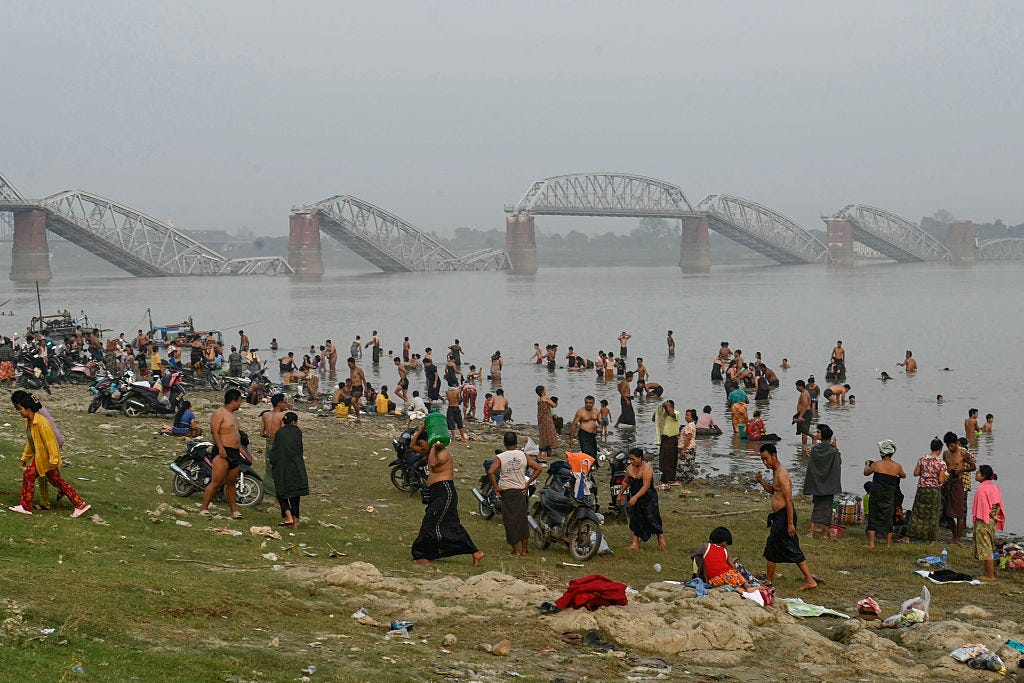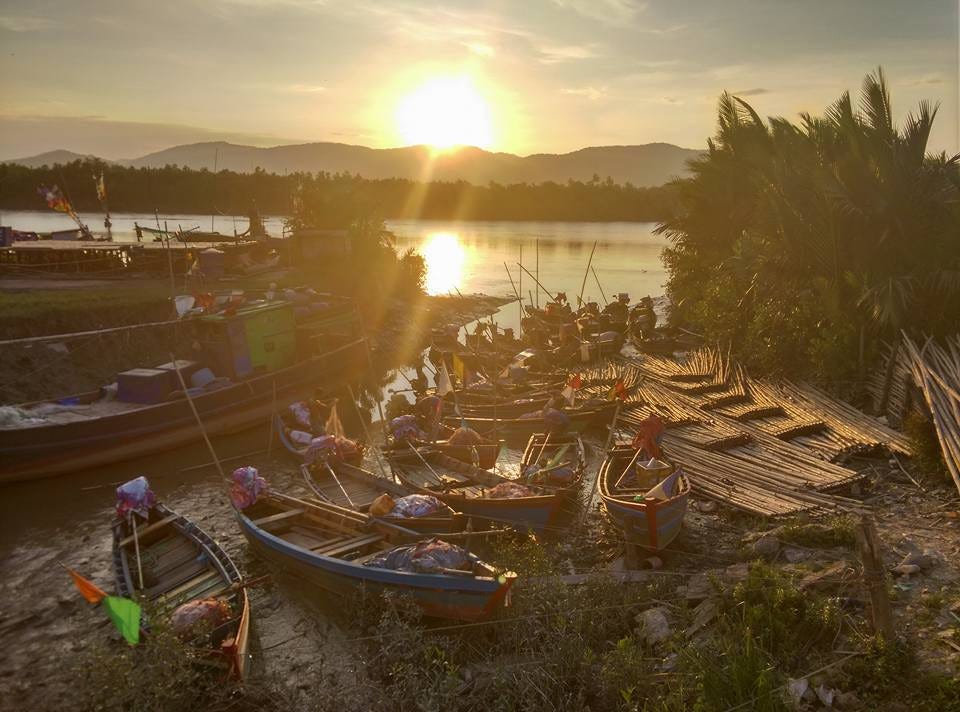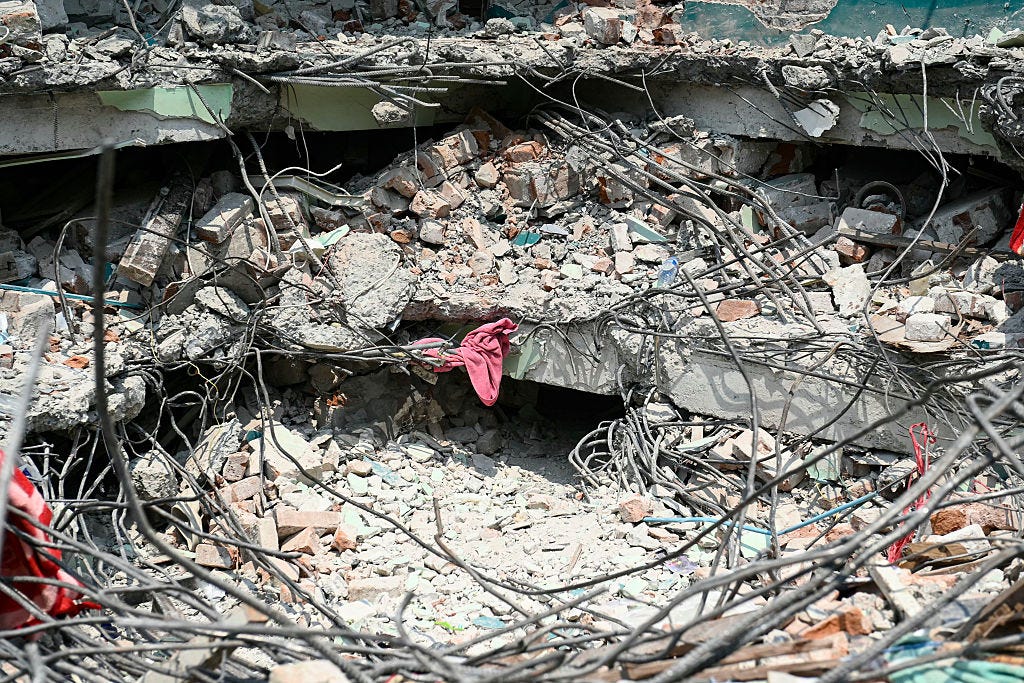Power, Plunder, and What Lies Beneath
Mining boom and post-quake gloom in Myanmar
I just noticed a theme in the past three issues of Thin Ink: Ukraine’s black soils, India’s groundwater crisis, and the earthquake in Burma/Myanmar and the fight for land in Southeast Asia. Well, we’re staying firmly on the ground this week too.
We’re returning to my home country to talk about the rush for precious minerals that are underground and the quake’s aftermath in one of the hardest hit areas, based on stories published by two exiled Burmese news outlets.
Full disclosure: I’ve been mentoring them for over a year, including for both of these stories. I’m sharing them to get Myanmar back in people’s consciousness and showcase the work of people who have been navigating very tricky waters.
Both newsrooms are small, independent, and have specific geographical focuses: Dawei Watch on what’s happening in Tanintharyi, the southernmost region in Myanmar, and Myaelatt Athan on central Myanmar, including areas hardest hit by the recent earthquake.
Both have been affected by the Trump cuts, which have hobbled their capacity. I hope these stories show their commitment and inspire some to up their support for local newsrooms.
The Resource Curse
People are often surprised when they learn how big Myanmar is. Because it’s so low on the international radar, they assume it is a tiny place in the middle of nowhere.
But it’s a nation of estimated 54 million people wedged between two of the world’s most populous nations with nuclear arms - India and China.
In terms of land size, it’s bigger than Afghanistan, Spain, France, and Germany and twice as big as Italy.
Its western, south, and southwestern parts make up a long coastline that opens up to the Bay of Bengal and the Andaman sea. It also shares a very long and porous border with Thailand in the southeast.
In other words, it’s a big country.
It’s also rich in natural resources: petroleum, natural gas, timber, precious stones (Burmese ruby and jade are world-famous), and a lot of minerals including rare earth.
Whether you’re a believer or a sceptic of “the Natural Resource Curse”, one thing that has remained true in Myanmar is that a vast majority of this wealth has not gone towards the country’s development. Successive military rulers have relied on the extractive industry to prop up their kleptocratic regimes. For a very long time, there was little anyone can do or say to rein them in.
The brief window of flawed-but-more-democratic rule between 2013 and 2021 changed that. In 2014, the government, led by a former general from the military-backed party, actually joined the Extractive Industry Transparency Initiative (EITI) and vowed to be more open about where the money was going and who owns and controls the extractive companies operating in Myanmar.
This emboldened ordinary people who care about the environment to speak out and set up civil society organisations to monitor violations. Regardless of who was in power, it was very challenging to be an environmental activist in Myanmar. There were lots of threats and intimidation as well as physical harm.
But the nascent community was building their own networks and becoming more outspoken when the coup happened. Now much of that work has disappeared and those who are still doing it have to navigate an extremely challenging environment - a combination of widespread insecurity caused by an ongoing civil war and more oppression from the military junta.
All this has also made it that much harder for newsrooms to investigate the situation on the ground.
Mining in Tanintharyi
Still, many continue to do so - Dawei Watch being one - because they know that scrutiny is needed now more than ever.
Much of international reporting on the extractive industry tends to focus on Kachin, the northernmost state bordering China and home to the jade and rare earth mines. But there is a long history of illegal and unregulated deforestation and mining in Tanintharyi, the “leg” of Myanmar.
This region occupies the long, narrow strip of land that borders Thailand to the east. It is among the most sparsely populated of Myanmar’s 15 states and regions and two-thirds of its population live in rural areas.
Two ethnic armed organisations, the New Mon State Party and the Karen National Union (KNU), have operated there for years. The latter is the oldest group that has been fighting the junta, which means a low-level conflict has been bubbling in the state since British independence.
Within Myanmar, Tanintharyi is known for beautiful white-sand beaches and the stunning colonial architecture that dots the two main towns of Dawei and Myeik.
With environmentalists and conservationists, it is famous as a biodiversity hotspot, where indigenous and globally threatened plants and animals reside, and as home to some of the Mekong/Indo-Burma region’s largest remaining evergreen forests.
But what draws unscrupulous profiteers from near and far is its rich mineral reserves - tin, tungsten, lead, gold, platinum, etc.
These have been mined on an industrial scale since the British colonial era but that expanded when foreign firms entered the region in the 1990s and exported the metals to Thailand, China and Malaysia, according to local media outlet Frontier Myanmar. This has caused widespread land confiscation and displacement.
The situation has deteriorated significantly since the coup, according to Dawei Watch’s latest report published in Mongabay. The team focused mostly on lead mines. Lead is a toxic metal that the World Health Organization called “one of 10 chemicals of major public health concern”.
They spent weeks and months manually tracing the mines’ locations using satellite images from Google Earth and Copernicus. They then compared the differences between pre-coup and post-coup eras and confirmed their calculations with on-the-ground reporting and speaking to local sources. So the numbers are estimates, but what they managed to find was still shocking.
The findings
Since 2021:
The number of mining sites has doubled and the amount of land being mined has more than tripled.
Given that community protests and a complex licensing process have disappeared with the coup, there is now a boom in lead mines, driving land prices to unprecedented heights.
Orchards, farmland and rubber plantations have become mines, and pollution and dangerous extractive activities that were once confined to riverbanks and streams have expanded into gardens, residential areas, and even next to a police station.
Many are operated by opportunistic local businessmen or outsiders who reportedly pay the various armed groups present in the region - the military junta and its proxy militias, the pro-democracy forces, and ethnic armed organisations - to access these resources.
The mine that hugs the back fence of a police station is operated by Delco, a company owned by the leader of a junta-backed militia.
The mined lead ore is then exported to Thailand, primarily through the land border but also via waterways to Ranong, a border province.
These sites have have devastated farmland, degraded soil, and killed aquatic life in rivers and streams, with sediment from the mines causing trees to wither and die and the Dawei River to become silted in parts.
Locals say they have to find alternative sources of drinking water, and many of those who come into contact with the polluted waters have developed skin rashes.
The story is worth reading in full. You can find it here.

Quake compounds Sagaing’s challenges
Unlike Tanintharyi, much of Sagaing used to be a relatively peaceful agricultural region. The capital, also known as Sagaing, is perched on the famous Ayeyarwady River and sits across from Mandalay, its better-known cousin.
I remember visiting the town and its surrounding hills, famed for their ancient pagodas, nunneries, and monastic schools, as part of our family pilgrimage when I was young.
I also remember how some of us walked along the riverbank, going up and down the rudimentary, uneven paths, instead of taking the long-tailed boats that took you on a swift but precarious journey. After a couple of trips on those narrow boats, I joined the walking crew.
This was the Bamar heartland, home of the Buddhist Bamar majority. It was also a reliable recruiting ground for the military. Things have shifted dramatically since the coup though, as this finely sketched piece by The New Humanitarian showed.
“While a major infantry division is based in Sagaing City, surrounding areas are under the control of the PDF, and the state has become the site of intense fighting between the junta and opposition forces, putting civilians in the crossfire. It has also come under regular junta bombardment.”
“According to ACAPS, a non-profit specialising in independent humanitarian analysis, the Sagaing region has experienced “the highest recorded number of aerial, shelling, and other explosive attacks nationwide”, and in 2022 it was reportedly enduring more than 40% of all junta airstrikes.”
“Even before the earthquakes, 2.7 million people were in need of assistance in the region, according to the non-profit Data Friendly Space (DFS), which added that it also “bears the highest landmine/UXO (unexploded ordnance) casualty rate nationwide”.”
What this means is that Sagaing was woefully unprepared for a natural disaster of this magnitude, especially during the hottest time of the year. Unfortunately, the epicentre of the quake was a mere 15 km away from the town.
Reporting by Myaelatt Athan showed that essential needs like food, shelter, and medical assistance remain unmet for many survivors. Healthcare workers, most of them volunteers, fear that a lack of humanitarian aid, a lack of water and sanitation, and the scorching heat may unleash further casualties.
It was a tough story to work on for many reasons. Local contacts were themselves affected by the quake and talking to anyone was very difficult, because the military’s regular communication and mobile service blackouts were compounded by damages to infrastructure and power lines.
Read the full story here.
Plunder at the global level
I’ve been fixated by all that is going on under our feet: the resources we’re extracting, the way agricultural practices and conflicts are affecting our soils and groundwater, and the seismic activity that can unleash devastation.
I know the science behind the earthquake. Still - and here’s where my superstitious Burmese upbringing is coming in - I can’t help but feel the tremors portend a message.
Perhaps some of you celebrated Earth Day on April 22. This year’s theme, “Our Power, Our Planet”, is about renewable energy, but it made me think more literally, given the power imbalances that are inherent in our climate, biodiversity, and food systems challenges.
It also made me think of Pope Francis, who passed away a day before Earth Day and who was an outspoken defender of protecting the climate.
The same day, a coalition of media outlets that care about climate change launched the 89 Percent Project, referring to the percentage of global population who want their governments to address this issue.
But the week rounded up with two pieces of news that are awful for our environment.
The U.S. Securities and Exchange Commission (SEC) approved the listing of Brazil-based JBS, the world’s largest meat producer with a massive carbon footprint and a well-documented history of deforestation and human rights violations.
The decision “exposes deep, systematic weaknesses in the US financial system and a failure to prevent harm to people and planet”, Global Witness said in a statement.
On Thursday (Apr 24), Trump issued an executive order directing the National Oceanic and Atmospheric Administration (NOAA) to allow deep-sea mining despite objections by more than 30 countries.
The order “would bypass the authority of the International Seabed Authority (ISA), a U.N.-affiliated agency which is in the midst of considering standards for deep-sea mining across the world”, the Ocean Conservacy said in a statement condemning the move.
So whose planet is this? Who has the power? Why are we plundering it to death? And why are we rewarding those at the forefront of the plunder?
Thin’s Pickings
Three ways Pope Francis influenced the global climate movement - The Conversation
Celia Deane-Drummond, Professor of Theology and Director of Laudato Si' Research Institute at the University of Oxford, on Pope Francis’ contribution to the fight against climate change, including his concern for the vulnerable and the downtrodden, who tend to suffer the most from climate impacts.
Lest we forget, his stance on climate was an unpopular one with American conservatives, who seem to view the existential crisis of our time as a non-moral one. Perplexing. On second thought, perhaps not.
Climate TRACE Releases February 2025 Emissions Data - Climate TRACE
This is the data project backed by Al Gore. It has interesting information on greenhouse gas emissions in February 2025 by sector, by city, and country.
What caught my eye though was its data on agriculture emissions: 554.62 million tonnes CO2e. Unchanged from February 2024.
Glossary: Carbon Brief’s guide to 25 ‘climate-friendly’ farming methods - Carbon Brief
If you’ve wondered what’s the difference between carbon farming, carbon-neutral farming, climate-friendly farming and climate-smart agriculture, fear not. This glossary will help you make sense of the similarities, the differences, and everything in between.
Op-ed: What It Will Take to Ban Ultra-Processed Food in School Meals - Civil Eats
“A UPF ban might help students eat better, but only if schools, and school kitchen staff, get the support they need to succeed with the changes,” writes Dan Giusti, who has been featured before in Thin Ink.
Dan should know. He runs a company that brings chefs to help school meal programmes to move away from UPFs.
As always, please feel free to share this post and send tips and thoughts on bluesky @thinink.bsky.social, mastodon @ThinInk@journa.host, my LinkedIn page, twitter @thinink, or via e-mail thin@thin-ink.net.









Hello Thin,
Nothing like being slapped in the face then again and again. Will it ever cease? I sometimes wonder whether the intense mining and mineral extraction that went on in Sagaing region had some direct causation relationship to the big Earthquake. I know all the gas extraction in parts of USA, particularly where there was a lot of concentrated drilling was known to lead to small tremors and small earthquakes. I hope that you keep your health in such painful, stressful, life in your midst